Introduction
The Keeper AI Standards Test is an essential tool designed to evaluate the reliability and effectiveness of AI-driven software such as Keeper AI. It ensures that the systems conform to industry standards for security, performance, and user experience. For individuals and businesses that rely upon AI for tasks such as data management, security, and automation, passing the test proves the tool’s capabilities and compliance with the highest operational standards.
In this article, we’ll cover everything you must know about this test, known as the Keeper AI Standards Test, including its purpose, tips for preparation, and the ways in which it will benefit AI developers and users.
What is the Keeper AI Standards Test?
Keeper AI Standards Test The Keeper AI Standards Test is an examination that determines whether AI software, such as Keeper AI, meets specific requirements regarding speed, security, accuracy, and user satisfaction. The test is designed to ensure that AI-driven applications focus on providing security, reliability, and effective services to their users.
The test is a comprehensive assessment of several important areas:
- Secure Data: Validating whether the AI tool protects user’s data and protects it from cyber-attacks.
- Operating Efficiency: Making sure that AI processes run without interruption or mistakes.
- UX: Analyzing the user experience design accessibility of the AI platform.
- Accuracy and precision: Evaluating the tool’s ability to do the job correctly and impart precise responses.
Passing this Keeper AI Standards Test is crucial for firms like Keeper AI, as it proves that their systems are durable, secure, and aligned with excellent practices.
Why is the Keeper AI Standards Test Important?
- Ensures Security and Privacy
- The test thoroughly tests the security features of Keeper AI to ensure that the system can handle sensitive information while shielding against unauthorized access.
- Builds User Trust
- After passing the standards test, Keeper AI demonstrates its reliability and builds trust in its capacity to deliver consistently.
- Improves Functionality
- The test evaluates the features and functions of Keeper AI. It helps identify areas for improvement and enhance the software’s overall performance.
- Guarantees Compliance
- A lot of industries are governed by strict security and protection of data standards. Keeper AI Standards Test ensures the software complies with these standards, reducing compliance and legal risk.
What Does the Keeper AI Standards Test Cover?
The test tests Keeper AI in a variety of dimensions that include:
- Protocols for Data Protection: Ensuring that strong security and encryption structures are set up.
- Performance and reliability : Check that the AI system is operating with minimum interruptions and downtime.
- Precision of AI Responses The measurement of the accuracy of AI’s responses is vital for data integrity.
- User Accessibility and Quality of Interface Assessing the ease at which users interact and benefit from AI.
- Conformity in line with Industry Standards: Ensuring that the AI is in line with the GDPR and CCPA, as well as other data privacy laws as applicable.
Preparing for the Keeper AI Standards Test: Step-by-Step Guide
To warrant that your Keeper AI device meets the standards for testing, Follow these steps:
Step 1: Strengthen Data Security Protocols
- Review Encryption Techniques
- Keeper AI should employ advanced encryption techniques to protect information. Check that your system’s encryption is current and covers all kinds of data.
- Enable Multi-Factor Authentication (MFA)
- The addition of MFA increases data security by requiring multiple methods of authentication. This is essential to pass the security section of the test.
- Run Security Checks Regularly
- Regularly conduct security audits in order to spot any weaknesses. This could include a scan for malware, access attempts, as well as data leaks.
Step 2: Optimize Operational Efficiency
- Analyze System Performance
- Utilize performance analysis tools to check Keeper AI’s speed and performance. Make changes if you observe slowdowns or issues with performance.
- Minimize System Downtime
- Check the scheduled maintenance does not affect The Keeper AI’s functionality. Ideally, the downtime should be as low as possible and scheduled for non-peak hours.
- Enhance Processing Speed
- You should consider upgrading the system’s infrastructure in the event that processing tasks take too long. Fast response times are vital for getting through the test’s operational efficiency component. The test.
Step 3: Improve User Experience
- Design a User-Friendly Interface
- It is important to ensure that the interface is clear and simple to use. For those who are not tech-savvy, this is particularly important since it will allow for an improved experience.
- Provide Accessibility Options
- Accessibility options, such as reading with screen readers or adjusting language preferences, make AI more accessible for an audience of different types.
- Test for Responsiveness
- Check the AI’s ability to respond to inputs from the user to ensure seamless interaction. This will assist in passing the assessment of user experience on the examination.
Step 4: Boost Accuracy and Precision of AI Responses
- Train Keeper AI on Quality Data
- Make sure you have a well-organized set of data for learning to warrant the highest accuracy of responses. The quality of the training data directly affects the AI’s capacity to provide precise payoff.
- Regularly Update the AI’s Knowledge Base
- The Update Keeper AI with current information that is relevant to its work. This will ensure that the AI is accurate and current.
- Conduct Accuracy Tests
- Test the accuracy of Keeper AI’s response and make any adjustments needed. The continually accurate payoff will increase the payoff of tests.
Phase 5: Make sure you align the Step 5: Align Compliance Standards
- Understand Compliance Requirements
- If your business is subject to compliance regulations such as GDPR, CCPA, and HIPAA, ensure Keeper AI meets its legal obligations.
- Consult Compliance authorities
- Consulting with experts can assist you in aligning the data handling practices of Keeper AI with industry standards, ensuring compliance is a breeze.
- Document Compliance Processes
- Maintain clear documentation of the way Keeper AI meets compliance requirements and can prove helpful during the review process.
Tips for Successfully Passing the Keeper AI Standards Test
- Perform plan Checks
- Always check your system for changes or problems since consistency is essential to passing the standard test.
- Gather User Feedback
- Gather feedback from users in order to pinpoint points for improvement. The resolution of user issues can make an enormous difference to overall AI performance.
- Stay Informed on Industry Standards
- The AI field is evolving rapidly. Therefore, we warrant that your system is up-to-date with the most recent standards for security precision, accuracy, and conformity.
Conclusion
This Keeper AI Standards Test is essential to ensure that your Keeper AI is secure as well as efficient and user-friendly. Making adjustments to your AI to comply with the requirements of these standards isn’t only about passing a test but also all about building trust, ensuring the security of your users, and providing them with an exceptional experience. If you follow the steps laid out in this document, it is possible to build Your Keeper AI to comply with or surpass the requirements to warrant its security and functionality for everyday use.
FAQs about Keeper AI Standards Test
1. How often do I need to take my Keeper AI Standards Test?
It is recommended that you take the test at least once each year or after major modifications to warrant that you are in constant compliance and perform.
2. What happens what happens if Keeper AI fails the standards test?
If you fail If it fails, you’ll be given feedback on areas that require improvement. This will enable you to adjust your test and take the test again.
3. Is the Keeper AI Standards Test mandatory for all users?
Although not required pas,sing the test can be extremely beneficial since it boosts confidence and proves the AI’s credibility.
4. How do you think the testing procedure will take?
The duration of the test varies, but it usually ranges from several hours to one day, depending on the complexity of the device being tested.
By focusing on security, performance, user experience, accuracy, and compliance, you’ll be able to create an AI system that meets the industry’s expectations and user demands.
Also Checkout: What is “Alaya AI” ? Everything You Need To Know





